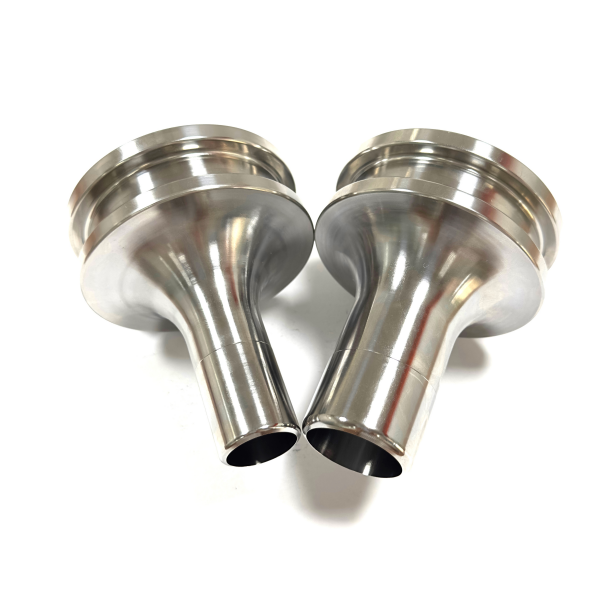What is CNC Milling and Turning?
CNC (Computer Numerical Control) machining is an automated manufacturing process that uses computer-controlled tools to produce precise components. Among the most widely used types of CNC machining are CNC milling and CNC turning. Both processes are crucial for producing high-precision parts, but they differ in how they work and the types of parts they create.
Table of Contents
- What is CNC Milling?
- What is CNC Turning?
- CNC Milling vs. CNC Turning: Key Differences
- Key Differences at a Glance
- Advantages and Applications
· CNC Milling
· CNC Turning - Choosing Between CNC Milling and CNC Turning
- Conclusion
What is CNC Milling?
CNC milling is a subtractive manufacturing process that uses computer-controlled rotating cutting tools to remove material from a fixed workpiece. It is capable of producing highly precise and complex parts by moving the tool along multiple axes (typically 3 to 5). CNC milling is commonly used in industries such as aerospace, automotive, electronics, and mold making.
Common CNC Milling Operations:
- Face Milling :Used to create flat surfaces on the top of a part. The cutting is done primarily with the end or face of the tool.
- Peripheral Milling (Side Milling) The cutting takes place along the sides of the tool to machine vertical surfaces or contours.
- Slot Milling:Used to cut slots or grooves into the material.
- Pocket Milling:Removes material from an enclosed cavity within the workpiece.
- Drilling :Performed with drill bits to create round holes, often integrated into milling machines.
- Chamfer Milling :Used to create beveled edges, often for safety, aesthetics, or assembly fit.
- Thread Milling :Involves cutting threads into a part using a milling tool.
- Contour Milling:Follows a complex path or curve to produce intricate shapes.
Components of a CNC Milling Machine:
- CNC Controller:Interprets the machining program (G-code) and controls the movement of the machine’s components.
- Spindle:Holds and rotates the cutting tool at high speeds for material removal.
- Worktable:Supports and secures the workpiece; can move in X, Y, and sometimes Z directions.
- Cutting Tools:Various tools such as end mills, drills, and face mills for specific machining tasks.
- Tool Changer:Automatically changes tools during machining without manual intervention.
- Coolant System:Delivers coolant to reduce heat and extend tool life.
- Machine Frame & Enclosure:Provides structural support and safety; helps contain chips and coolant.
Applications of CNC Milling:CNC milling is widely used in industries that demand high precision, complex geometries, and tight tolerances. It is ideal for machining a variety of materials, including both metals and plastics, for the production of prototypes as well as end-use parts.Typical application fields include aerospace,automotive,electronics,medical,and mold making.
What is CNC Turning?
CNC turning is a machining process in which a cutting tool removes material from a rotating workpiece to create cylindrical parts. The process is performed on a CNC lathe, where the workpiece spins while the cutting tool moves along one or more axes to shape the exterior (and sometimes interior) of the part.
CNC turning is ideal for producing symmetrical components such as shafts, bushings, pulleys, and threaded parts with high precision and efficiency.
Common CNC Turning Operations:
- Facing: Cutting across the end of the rotating workpiece to produce a flat surface.
- OD Turning (External Turning): Machining the external diameter of the workpiece to reduce its size or create specific shapes.
- ID Boring: Enlarging or finishing an existing hole inside the workpiece.
- Grooving: Cutting narrow grooves or recesses into the internal or external surface of the part.
- Threading: Creating internal or external threads on the workpiece using special threading tools.
- Parting (Cut-off): Cutting off a finished part from the raw material bar or blank.
- Drilling: Creating holes on the centerline of the rotating workpiece using drill bits.
Components of a CNC Turning Machine:
- CNC Controller: Interprets the machining program (G-code) and controls all machine movements.
- Spindle : Rotates the workpiece at high speeds; a core component of turning operations.
- Chuck : Holds and secures the workpiece during machining.
- Tool Turret: Holds multiple cutting tools and indexes them into position as needed.
- Bed: The base structure that supports the entire lathe and ensures stability.
- Tailstock : Provides additional support for long workpieces.
- Coolant System: Delivers coolant to reduce heat and extend tool life during machining.
- Chip Conveyor: Automatically removes metal chips generated during machining.
Applications of CNC Turning: CNC turning is widely used for machining high-precision cylindrical components, offering excellent dimensional accuracy and surface finish. It is especially suitable for producing rotationally symmetric parts and is commonly used in both prototyping and mass production.Typical application fields include:automotive industry ,aerospace,medical devices,electronics,industrial equipment
CNC Milling vs. CNC Turning: Key Differences
| Aspect | CNC Milling | CNC Turning |
| Workpiece movement | Stationary | Rotates |
| Tool movement | Rotates and moves along multiple axes | Stationary, moves linearly (X and Z axes) |
| Ideal for | Complex shapes, surfaces, slots, holes | Cylindrical and symmetrical parts |
| Typical machine | CNC milling machine (vertical/horizontal) | CNC lathe |
| Precision | ±0.001 in (0.025 mm) | ±0.0005 in (0.0127 mm) |
| Common applications | Aerospace parts, molds, enclosures, brackets | Shafts, bushings, threaded components, pins |
Key Differences at a Glance
CNC milling and CNC turning are two fundamental types of computer numerical control (CNC) machining. They differ mainly in how material is removed and how the tool and workpiece move:
CNC milling uses a rotating cutting tool that moves along multiple axes to cut a stationary workpiece. It is ideal for machining complex geometries, multi-surface parts, and components with holes or contours.
CNC turning, on the other hand, involves rotating the workpiece while a stationary cutting tool removes material. This process is particularly well-suited for cylindrical or symmetrical parts, such as shafts and bushings.
In short:
Milling = rotating tool + stationary workpiece → for complex shapes
Turning = rotating workpiece + stationary tool → for round parts
Advantages and Applications
CNC Milling
Advantages:
- Versatility:CNC milling can handle a wide range of materials, including metals and plastics, and is capable of producing complex geometric designs.
- Precision:It is highly suitable for manufacturing intricate and high-precision parts, especially those with non-rotational shapes.
- Multi-Operation Capability:Multiple processes such as milling, drilling, and tapping can be performed in a single setup, improving both efficiency and consistency.
Applications:
- CNC milling is widely used across various industries, particularly for parts that require high complexity, precision, and surface quality:
- Aerospace: Structural components, brackets, access panels
- Automotive: Mold parts, housings, engine components
- Electronics: Heat sinks, precision brackets, enclosures
- Medical Devices: Surgical tools, casings, non-standard precision parts
- Mold Making: Injection mold cavities and cores, die casting molds
CNC Turning
Advantages:
- High Efficiency:CNC turning offers fast production speeds, making it ideal for high-volume manufacturing of cylindrical or symmetrical parts.
- Excellent Precision for Round Parts:Delivers high accuracy, excellent concentricity, and fine surface finishes for components such as shafts, sleeves, and threaded parts.
- Cost-Effective for Simple Geometries:Especially suitable for simple, rotational parts with short cycle times and lower machining costs.
Applications:
- CNC turning is widely used across industries for producing symmetrical, high-precision components, including:
- Automotive: Shafts, bolts, hubs, sleeves
- Aerospace: Precision axles, connectors, fasteners
- Medical Devices: Orthopedic screws, implants, cylindrical surgical parts
- Electronics: Connectors, terminals, miniature rotating parts
- Industrial Machinery: Rollers, pins, guide bushings, linkage rods
Choosing Between CNC Milling and CNC Turning
Choose CNC Milling if:
You need to machine multiple surfaces or features in one setup
The part is not symmetrical around an axis (non-rotational)
You require tight tolerances on features like holes, slots, or flat faces
Your design involves 3D shapes or intricate detailing
Choose CNC Turning if:
Your part is cylindrical or rotationally symmetrical (e.g., shafts, pins, bushings)
You require high concentricity and smooth surface finishes
The design includes threads, grooves, or round profiles
You are producing high volumes of round parts efficiently
The machining operation involves primarily two axes (X and Z)
Some advanced CNC machines feature turn-mill capabilities, integrating both milling and turning operations into a single setup. This allows for the efficient and precise machining of complex parts—such as camshafts with milled keyways and other irregular rotational components.
Conclusion
CNC milling is well-suited for machining parts with complex geometries and multiple surfaces, while CNC turning is ideal for the efficient and high-precision production of cylindrical components. Each process has its own advantages and should be selected based on the part’s structural characteristics and production requirements. For certain complex projects, combining milling and turning operations can significantly enhance overall machining efficiency and accuracy, meeting the diverse and high-quality demands of modern manufacturing.






